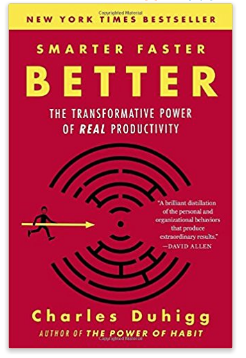I recently read “Smarter Faster Better: The Secrets of Being Productive in Life and Business” by Charles Duhigg. Below are the quotes I found most interesting. If you like them, buy the book here.
 “Motivation is triggered by making choice that demonstrate to ourselves that we are in control. The specific choice we make matters less than the assertion of control. It’s this feeling of self-determination that gets us going.” (20)
“Motivation is triggered by making choice that demonstrate to ourselves that we are in control. The specific choice we make matters less than the assertion of control. It’s this feeling of self-determination that gets us going.” (20)
“We should reward initiative, congratulate people for self-motivation, celebrate when an infant wants to feed herself. We should applaud a child who shows defiant, self-righteous stubbornness and reward a student who finds a way to get things done by working around the rules.” (36)
“When we start a new task, or confront an unpleasant chore, we should take a moment to ask ourselves “why…” Once we start asking why, those small tasks become pieces of a larger constellation of meaningful projects, goals, and values.” (36)
“Project Oxygen found that a good manager 1) is a good coach; 2) empowers and does not micromanage; 3) expresses interest and concern in subordinates’ success and well-being 4) is results oriented; 5) listens and shares information; 6) helps with career development; 7) has a clear vision and strategy; 8) has key technical skills.” (43)
“They were all behaviors that created a sense of togetherness while also encouraging people to take a chance. We call it ‘psychological safety…’ a shared belief, held by members of a team, that the group is a safe place for taking risks. It is a sense of confidence that the team will not embarrass, reject, or punish someone for speaking up.” (50)
“The right norms could raise the collective intelligence of mediocre thinkers. The wrong norms could hobble a group made up of people who, on their own, were all exceptionally bright.” (60)
“All the members of the good teams spoke in roughly the same proportion… conversations didn’t need to be equal every minute, but in aggregate, they had to balance out.” (60)
“The good teams tested as having “high average social sensitivity” – a fancy way of saying that the groups were skilled at intuiting how members felt based on their tone of voice, how people held themselves, and the expressions on their faces.” (61)
“For psychological safety to emerge among a group, teammates don’t have to be friends. They do, however, need to be socially sensitive and ensure everyone feels heard.” (64)
“Teams need to believe that their work is important.
Teams need to feel their work is personally meaningful.
Teams need clear goals and defined roles.
Team members need to know they can depend on one another.
But, most important, teams need psychological safety.” (66)
“People who know how to manage their attention and who habitually build robust mental models tend to earn more money and get better grades.” (92)
“If you want to make yourself more sensitive to the small details in your work, cultivate a habit of imagining, as specifically as possible, what you expect to see and do when you get to your desk.” (92)
“Narrate your life, as you are living it, and you’ll encode those experiences deeper in your brain.” (92)
“Mental models help us by providing a scaffold for the torrent of information that constantly surrounds us. Models help us choose where to direct our attention, so we can make decisions, rather than just react.” (101)
“Employees work smarter and better when they believe they have more decision making authority and when they believe their colleagues are committed to their success. A sense of control can fuel motivation, but for that drive to produce insights and innovations, people need to know their suggestions won’t be ignored, that their mistakes won’t be held against them. And they need to know that everyone else has their back.” (165)
“At the intermediate level, you want to know as many rules as possible. Intermediate players crave certainty. But elite players can use that craving against them, because it makes intermediate players more predictable.” (173)
“The future isn’t one thing. Rather, it is a multitude of possibilities that often contradict one another until one of them comes true. And those futures can be combined in order for someone to predict which one is more likely to occur.” (179)
“We can always find the right story when we start asking ourselves what feels true,” Del Vecho told me. “The thing that holds us back is when we forget to use our lives, what’s inside our heads, as raw material” (223)
“Creativity can’t be reduced to a formula. At its core, it needs novelty, surprise, and other elements that cannot be planned in advance to seem fresh and new. There is no checklist that, if followed, delivers innovation on demand.
But the creative process is different. We can create the conditions that help creativity to flourish. We know, for example, that innovation becomes more likely when old ideas are mixed in new ways. We know the odds of success go up when brokers – people with fresh, different perspectives, who have seen ideas in a variety of settings – draw on the diversity within their heads. We know that, sometimes, a little disturbance can help jolt us out of the ruts that even the most creative thinkers fall into, as long as those shake-ups are the right size.” (235)
“If you want to become a broker and increase the productivity of your own creative process, there are three things that can help: First, be sensitive to your own experiences. Pay attention to how things make you think and feel. That’s how we distinguish cliches from true insights…
Second, recognize that the panic and stress you feel as you try to create isn’t a sign that everything is falling apart. Rather, it’s the condition that helps make us flexible enough to seize something new. Creative desperation can be critical; anxiety is what often pushes us to see old ideas in new ways. The path out of that turmoil is to look at what you know, to reinspect conventions you’ve seen work and try to apply them to fresh problems. The creative pain should be embraced.
Finally, remember that the relief accompanying a creative breakthrough, while sweet, can also blind us to seeing alternatives. It is critical to maintain some distance from what we create. Without self-criticism, without tension, one idea can quickly crowd out competitors. But we can regain that critical distance by forcing ourselves to critique what we’ve already done, by making ourselves look at it from a completely different perspective, by changing the power dynamics in the room or giving new authority to someone who didn’t have it before. Disturbances are essential, and we retain clear eyes by embracing destruction and upheaval, as long as we’re sensitive to making the disturbance the right size.” (236)
“When Alter conducts experiments, he sometimes gives people instructions in a hard-to-read font because, as they struggle to make out the words, they read the text more carefully. “The initial difficulty in processing the text leads you to think more deeply about what you’re reading, so you spend more time and energy making sense of it.” (247)
“Researchers found that hand writers scored twice as well as the typists in remembering what a lecturer said.” (265)
“Productivity doesn’t mean that every action is efficient. It doesn’t mean that waste never occurs. In fact, as Disney learned, sometimes you have to foster tension to encourage creativity. Sometimes a misstep is the most important footfall along the path to success.” (285)
Liked the quotes? Buy the book here.

